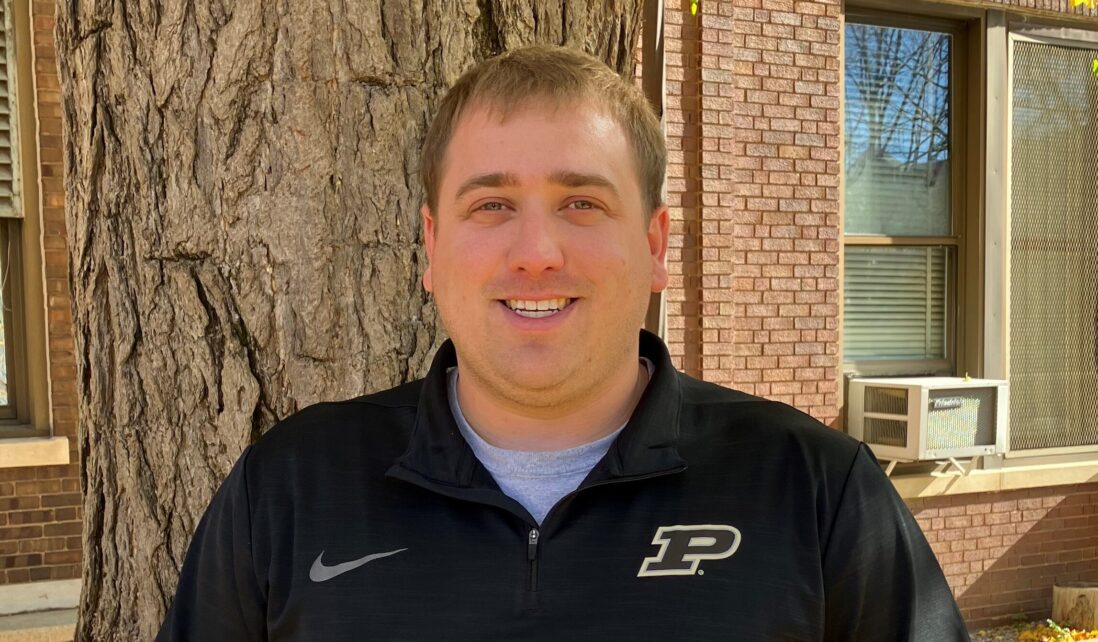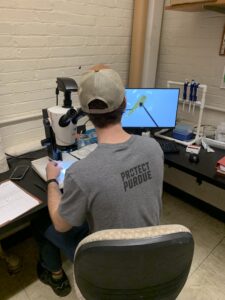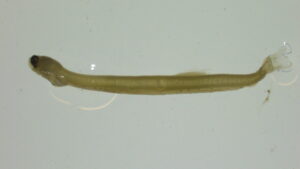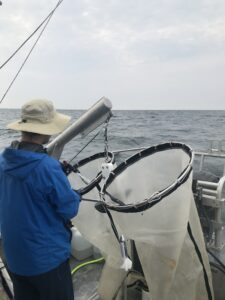
Meet Our Grad Student Scholars is a series from Illinois-Indiana Sea Grant (IISG) celebrating the graduate students doing research funded by the IISG scholars program. To learn more about our faculty and graduate student funding opportunities, visit our Fellowships & Scholarships page. Les Warren is a Ph.D. student in the Department of Forestry and Natural Resources at Purdue University. He is currently in his fourth year, researching the early life history of larval fish in the Laurentian Great Lakes. For the work being funded by the Great Lakes Fisheries Trust and Illinois-Indiana Sea Grant, he is particularly interested in how various natal habitats help contribute recruits to the Lake Michigan alewife population.

A researcher examines larval fish samples under a microscope. (Photo provide by Les Warren)
In the early 1940s, a small fish from the Atlantic Ocean, alewife (Alosa pseudoharengus), invaded the freshwater habitats of the Great Lakes. Lake Michigan was not excluded from this invasion, and alewife quickly spread throughout the lake. High densities of alewife began to degrade critical habitats and alewife carcasses clogged water intake pipes after winter die-offs. In the 1960s, successful stocking of Pacific salmonids like Coho and Chinook Salmon provided a much-needed predator for alewife. This led to both a decline in the alewife population and the establishment of a major recreational salmonid fishery.
Salmonids have since then become one of the largest recreational fisheries in Lake Michigan, and tourism and charter fishing targeting Pacific salmonids provide a strong economic impact for the surrounding states. Since the early 2000s, however, alewife populations have been on the decline and are currently at an all-time low. This decline in abundance could be attributed to several factors, including habitat degradation and the over-stocking of salmonid species. Although some species of salmonids are flexible in their diets, Coho and Chinook Salmon rely heavily on alewife for up to 90% of their diet.

A larval alewife collected from Lake Michigan. (Photo provide by Les Warren)
Les Warren, a PhD student in Hook Lab at Purdue University Department of Forestry and Natural Resources, is studying the early life history of alewife and how different habitats may influence the survival and growth of alewife in Lake Michigan. Alewife spawn in multiple habitats in Lake Michigan, including drowned river mouth lakes (DRMLs), tributaries, and nearshore environments. Due to its large volume compared to other habitats, the nearshore region of Lake Michigan has been considered the primary source of alewife recruits by previous studies using modeling approaches. However, the main basin of Lake Michigan has undergone ecological changes such as lower productivity offshore, greater water clarity and lower food web changes. These changes are attributed to actions such as lower nutrient loading from tributaries into the lake and the invasion of dreissenid mussels, which aggressively filter the water column. In the past, habitats like DRMLs provided warm, highly turbid environments with relatively high abundance of prey for young alewife to eat. Previous studies have observed young alewife in these environments experience relatively early hatch dates, high growth rates, and higher probability of survival than that of young alewife reared in the main basin of Lake Michigan.

A net to capture zooplankton is towed vertically through the water. (Photo provide by Les Warren)
Over the summers of 2021 and 2022, Les sampled nearshore habitats of Lake Michigan and supplemental habitats such as DRMLs and tributaries. Sampling locations included Muskegon Lake, White Lake, Trail Creek, and the Saint Joseph River on the eastern shoreline of Lake Michigan. At each location, larval alewife were collected using a paired bongo net and surface neuston net. A paired bongo net contains two nets of different mesh sizes to facilitate the capture of various sized larvae throughout the water column. Neuston nets target larval fish at the surface of the water column. Along with the larval fish tows, zooplankton, sonde profiles, ultraviolet radiation profiles, and secchi depths were collected to further compare these habitats spatially and temporally. With the collection of zooplankton at each site, Les was able to quantify the abundance of prey available for larval fish. Secchi depth is a way to compare water clarity between habitats and connects directly with exposure to ultraviolet radiation. One exciting aspect of this study was the ability to work with collaborators at Miami University to assess the amount of potential UV exposure for larval fish in each of these habitats.

A researcher examines bongo nets after they have been towed in Lake Michigan. (Photo provide by Les Warren)
Sampling on a weekly basis during two consecutive summers was a logistical challenge. Sampling for Les’s project required scheduling around weather, scientists’ time, and plans to share equipment with the other graduate students and researchers in his lab. However, Les claims that the real work began after bringing all the samples back to the lab. Each sample needed to be picked for larval fish since the nets are rinsed down and the resulting samples are concentrated on the boat. Undergraduate technicians sorted through other matter, including algae and zooplankton, to extract the larval fish from the samples. Once picked, the larvae species were identified before extracting otoliths — ear stones that exhibit alternating light and dark rings, similar to those of a tree — to determine the ages of the larval alewife.
Although the results of the study are in the early stages, the DRML and river mouth habitats were warmer, more turbid, and had higher zooplankton densities than Lake Michigan. Larval alewife emerged on average two weeks earlier in these habitats and, overall, relative larval densities and daily growth rates of larval alewife were higher in the DRMLs and river mouths compared to the nearshore waters of Lake Michigan during both sampling seasons. Results from this study will be compared to a previous study performed 20 years earlier to provide evidence that DRMLs and river mouths are becoming increasingly important habitats to sustaining a healthy alewife population in Lake Michigan.
Illinois-Indiana Sea Grant is a partnership between NOAA, University of Illinois Extension, and Purdue University Forestry and Natural Resources, bringing science together with communities for solutions that work. Sea Grant is a network of 34 science, education and outreach programs located in every coastal and Great Lakes state, Lake Champlain, Puerto Rico and Guam.
Contact: Carolyn Foley

